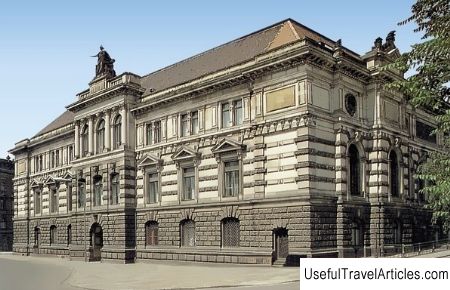Albertinum in Germany, resort of Dresden
Rating: 7,8/10 (1702 votes)  The magnificent Albertinum art gallery was built in 1887. The building was intended for Arsenal, and was named after the king of Saxony Albert, connoisseur and connoisseur of art. The museum building is located on the left bank of the Elbe and completes the Bruhlshe Terrasse. The Arsenal was the most modern Renaissance building in Europe: gables of three floors, two towers with internal staircases and a 13 meter wooden roof with numerous mansards and windows. The Arsenal was famous as a rich collection of the latest technology of that time, therefore it was visited with interest at different times by the emperors Maximilian and Matthias (1575 and 1617)., and twice Peter the Great (1698 and 1711) Like many structures in Dresden, Albertinum was completely destroyed during the period World War II. After reconstruction with modern innovations, it has become a miracle of museum architecture. In a modern solution, the courtyard of the cruciform structure is covered by a two-storey steel structure. At 17 meters above the ground, the museum workshops and storage facilities located inside this extension are well protected from possible impacts. The saved space of the courtyard is effectively used for the needs of the museum. The gallery's collection is represented by the Galleries of New and Old Masters, a printing room, a hall of coins and a kind of museum of the art industry. Galleries of new and old masters divided by artistic direction since 1931. Young, new masters – these are representatives of 19th century Hungarian, Roman, French and Polish painting. There is also expressionism and impressionism of Germany, many paintings in the style of romanticism and realism. The paintings of modernists of various currents were withdrawn from the exhibition by the Nazis as objects of 'degrading art', many were sold or perished during the war. At the heart of the exposition is the Museum of the Art Industry there is a collection of August the Strong, the famous German elector. There is a large number of gold and silver items, jewelry, ivory items from the 14th and 18th centuries. Among the world's artistic heritage are the rare Sculpture Collections of the Albertinum Museum. Its halls contain ancient sculptures of Egypt, Greece, Rome and Asian countries. The Printing Hall exhibits graphic series and paintings by 15th century artists, more than 180 thousand printed drawings. It is organically complemented by the exhibits of the Hall coins - seals and prints, including the Saxon period, a large number of rare medals and coins.  
We also recommend reading Church of St. Nicholas in Germany, Potsdam resort Topic: Albertinum in Germany, resort of Dresden. |




